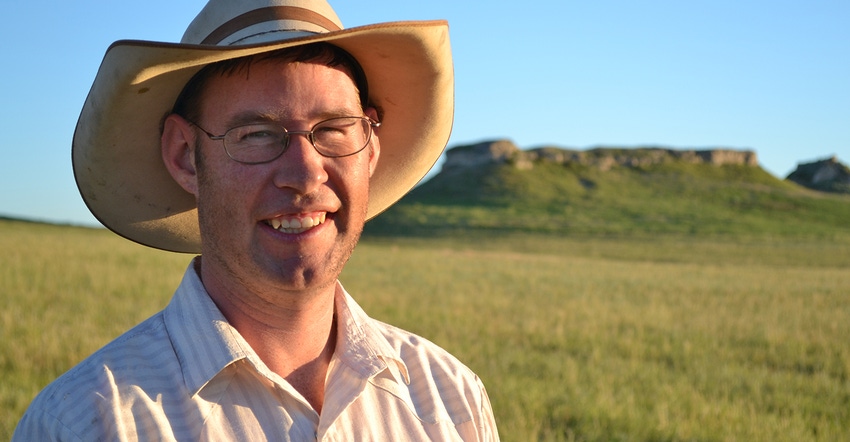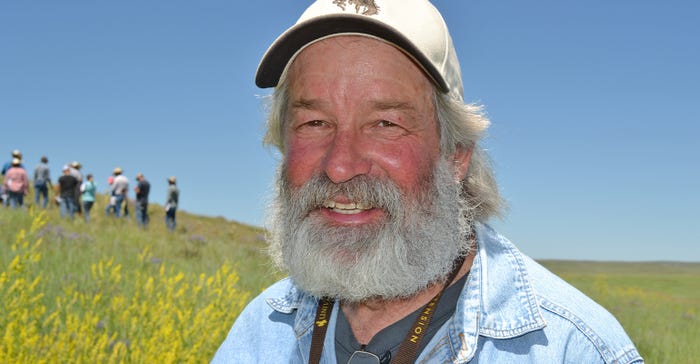July 24, 2019

Sage Askin says an intensively managed rest-rotation system on rangelands has significantly improved groundcover, which has bolstered the “solar panel” and, ultimately, plant growth. A key to that work is keeping cattle on the move.
“In the rangelands, when plants are actively growing in the spring, we move relatively quickly [every one to three days] through about 100-acre paddocks — with herds ranging between 300 and 400 cow-calf pairs or yearlings,” says Sage, who leases ranches in eastern Wyoming with his wife, Faith.
This only holds true for pastures slated to be grazed in the spring; pastures are never grazed at the same time each year, and some pastures receive a full year’s rest.
“This is definitely invigorating the native-grass community, both cool- and warm-season,” Sage says. “According to the USDA, big bluestem is one of the most palatable warm-season grasses. We didn’t see any big bluestem until recently, and now we’re seeing establishment in multiple places on the main ranch we lease. To me, this is a big indicator of the overall health of rangelands.”
Increases in forage production and the stocking rate have enabled the Askins to expand their business. They now have five enterprises: custom grazing 450 to 750 cow-calf pairs each year, custom grazing stockers, leasing cows, running sheep on shares and developing a heifer program. The latter involves breeding and selling their own heifers, which currently number 110.
“We believe we are developing a strong skill set to successfully manage land and get more profits per acre out of the land, compared to traditional, status quo ranching,” Sage says.
Next year, the couple plans to start moving cattle twice per day on rangelands from May to July and will also boost the stock density.
“To get our density up, we are now using even bigger herds, up to 600 to 900 yearlings in a pasture,” Sage says. “Stock density is a very powerful tool that can multiply the effect of each of the other grazing tools. If we change up the timing of use, it’s a good thing. If we do it with added density, it compounds the changes even faster.”

CONTINUING EDUCATION: Harold Stroh poses for a picture during the four-day Jim Gerrish Management-intensive Grazing School last year in Wyoming.

Successful ranchers aren’t reductionists
Continuing education is an important tool for the Askins and for Harold Stroh, who runs a much smaller operation in Wyoming.
Sage paid his way through college, where he earned a bachelor’s degree in rangeland ecology and watershed management from the University of Wyoming, along with five minors (soil science, wildlife and fisheries biology, forestry, agroecology, and reclamation and restoration ecology).
He took one semester off from school for an internship on the Rex Ranch, a large outfit in north-central Nebraska that practices Allan Savory holistic-style grazing management.
“In college and today’s business world, you naturally go toward being a reductionist, being very, very good at one thing,” Sage says. “That’s good in some fields; but to be successful in ranching, you need to think in terms of the whole, in terms of the big picture, rather than being a reductionist.”
Sage and Faith are alumni of Dave and Kathy Pratt’s Ranching for Profit School, which preaches that healthy lands lead to happy families and profitable businesses.
Faith, who graduated from the University of Wyoming with a degree in rangeland ecology and watershed management, also attended one of Jim Gerrish’s four-day Management-intensive Grazing schools.
They both grew up in agriculture families, but learning from others has broadened their skills — everything from grazing management to business decisions.
“It’s been rewarding to encompass our personal lifestyles with the ecology of our entire ranching system, and managing for the integrity of that system as a whole — not just one thing,” Faith says.
Stroh is a newcomer to ranching, so education has been critical. He reads agriculture-related magazines and books; learns from local folks, including ranchers and employees with the Natural Resources Conservation Service and Niobrara Conservation District; and attends workshops — among them, Gerrish’s MiG school.
“Jim is a proponent of intensively managed grazing systems and believes in taking only one-third to one-half of the grass in a paddock, and then getting out,” Stroh says. “Time is what matters. It’s not the number of head out there, it’s the time.”
Sage adds, “That has become our modus operandi, too. We take only a third, whether the grass is actively growing or has gone dormant, and have seen excellent animal performance.”
Waggener writes from Laramie, Wyo.
About the Author(s)
You May Also Like




